Bifunctional Nitrogen and Fluorine Co-Doped Carbon Dots for Selective Detection of Copper and Sulfide Ions in Real Water Samples
Abstract
:1. Introduction
2. Results and Discussion
2.1. Characterization of N, F-CDs
2.2. Fluorescence Stability of N, F-CDs
2.3. Detection of Cu2+ by N, F-CDs
2.4. Detection of S2− by N, F-CDs@Cu2+
2.5. Sensing Mechanism for the Detection of Cu2+ and S2−
2.6. Detection of Cu2+ and S2− in Real Water Samples
3. Materials and Methods
3.1. Reagents
3.2. Apparatus
3.3. Preparation of N, F-CDs
3.4. Detection of Cu2+ Ions
3.5. Detection of S2− Ions
3.6. Detection of Cu2+ and S2− in Real Water Samples
4. Conclusions
Author Contributions
Funding
Institutional Review Board Statement
Informed Consent Statement
Conflicts of Interest
Sample Availability
References
- Huang, G.; Luo, X.; Lin, W.; Tang, W.; Yue, T.; Wang, J.; Li, Z. Carbon dots based multicolor fluorescence sensor for ratiometric and colorimetric dual-model detection of Cu2+. Dye. Pigment. 2022, 203, 110381. [Google Scholar] [CrossRef]
- Lin, Y.-S.; Yang, Z.-Y.; Anand, A.; Huang, C.-C.; Chang, H.-T. Carbon dots with polarity-tunable characteristics for the selective detection of sodium copper chlorophyllin and copper ions. Anal. Chim. Acta 2022, 1191, 339311. [Google Scholar] [CrossRef] [PubMed]
- Lu, Z.; Chen, M.; Li, M.; Liu, T.; Sun, M.; Wu, C.; Su, G.; Yin, J.; Wu, M.; Zou, P.; et al. Smartphone-integrated multi-color ratiometric fluorescence portable optical device based on deep learning for visual monitoring of Cu2+ and thiram. Chem. Eng. J. 2022, 439, 135686. [Google Scholar] [CrossRef]
- El-Malla, S.F.; Elshenawy, E.A.; Hammad, S.F.; Mansour, F.R. Rapid microwave synthesis of N,S-doped carbon quantum dots as a novel turn off-on sensor for label-free determination of copper and etidronate disodium. Anal. Chim. Acta 2022, 1197, 339491. [Google Scholar] [CrossRef]
- Wang, F.; Gu, Z.; Lei, W.; Wang, W.; Xia, X.; Hao, Q. Graphene quantum dots as a fluorescent sensing platform for highly efficient detection of copper(II) ions. Sens. Actuators B Chem. 2014, 190, 516–522. [Google Scholar] [CrossRef]
- Torres Landa, S.D.; Reddy Bogireddy, N.K.; Kaur, I.; Batra, V.; Agarwal, V. Heavy metal ion detection using green precursor derived carbon dots. iScience 2022, 25, 103816. [Google Scholar] [CrossRef]
- Wu, X.; Meng, X.; Hou, B.; Sun, Z.; Zhang, Y.; Li, M. Rapid fluorescent color analysis of copper ions on a smart phone via ratiometric fluorescence sensor. Microchim. Acta 2022, 189, 67. [Google Scholar] [CrossRef] [PubMed]
- Meng, A.; Huangfu, B.; Sheng, L.; Hong, X.; Li, Z. One-pot hydrothermal synthesis of boron and nitrogen co-doped carbon dots for copper ion assay and multicolor cell imaging using fluorescence quenchometric method. Microchem. J. 2022, 174, 106981. [Google Scholar] [CrossRef]
- Shi, Y.; Wang, R.; Yuan, W.; Liu, Q.; Shi, M.; Feng, W.; Wu, Z.; Hu, K.; Li, F. Easy-to-Use Colorimetric Cyanine Probe for the Detection of Cu(2+) in Wilson’s Disease. ACS Appl. Mater. Interfaces 2018, 10, 20377–20386. [Google Scholar] [CrossRef]
- Hou, J.; Jia, P.; Yang, K.; Bu, T.; Zhao, S.; Li, L.; Wang, L. Fluorescence and Colorimetric Dual-Mode Ratiometric Sensor Based on Zr–Tetraphenylporphyrin Tetrasulfonic Acid Hydrate Metal–Organic Frameworks for Visual Detection of Copper Ions. ACS Appl. Mater. Interfaces 2022, 14, 13848–13857. [Google Scholar] [CrossRef]
- Li, H.Y.; Zhao, S.N.; Zang, S.Q.; Li, J. Functional metal-organic frameworks as effective sensors of gases and volatile compounds. Chem. Soc. Rev. 2020, 49, 6364–6401. [Google Scholar] [CrossRef] [PubMed]
- Duan, W.L.; He, B.; Nover, D.; Yang, G.S.; Chen, W.; Meng, H.F.; Zou, S.; Liu, C.M. Water Quality Assessment and Pollution Source Identification of the Eastern Poyang Lake Basin Using Multivariate Statistical Methods. Sustainability 2016, 8, 133. [Google Scholar] [CrossRef]
- Feng, X.J.; Zhang, H.Y.; Shi, M.X.; Chen, Y.P.; Yang, T.Y.; Fan, H.G. Toxic effects of hydrogen sulfide donor NaHS induced liver apoptosis is regulated by complex IV subunits and reactive oxygen species generation in rats. Environ. Toxicol. 2020, 35, 322–332. [Google Scholar] [CrossRef] [PubMed]
- Lin, V.S.; Chen, W.; Xian, M.; Chang, C.J. Chemical probes for molecular imaging and detection of hydrogen sulfide and reactive sulfur species in biological systems. Chem. Soc. Rev. 2015, 44, 4596–4618. [Google Scholar] [CrossRef] [PubMed]
- Eto, K.; Asada, T.; Arima, K.; Makifuchi, T.; Kimura, H. Brain hydrogen sulfide is severely decreased in Alzheimer’s disease. Biochem. Biophys. Res. Commun. 2002, 293, 1485–1488. [Google Scholar] [CrossRef]
- Wang, F.F.; Zhang, C.L.; Qu, X.T.; Cheng, S.S.; Xian, Y.Z. Cationic cyanine chromophore-assembled upconversion nanoparticles for sensing and imaging H2S in living cells and zebrafish. Biosens. Bioelectron. 2019, 126, 96–101. [Google Scholar] [CrossRef]
- Petrova, Y.Y.; Zol’nikov, Y.A. Sorption-catalytic method for the determination of copper (II) in combination with planar chromatography. Inorg. Mater. 2012, 48, 1328–1334. [Google Scholar] [CrossRef]
- Mashraqui, S.H.; Chandiramani, M.; Betkar, R.; Ghorpade, S. An easily accessible internal charge transfer chemosensor exhibiting dual colorimetric and luminescence switch on responses for targeting Cu2+. Sens. Actuators B Chem. 2010, 150, 574–578. [Google Scholar] [CrossRef]
- Singh, E.; Meyyappan, M.; Nalwa, H.S. Flexible Graphene-Based Wearable Gas and Chemical Sensors. ACS Appl. Mater. Interfaces 2017, 9, 34544–34586. [Google Scholar] [CrossRef]
- Wu, L.L.; Sedgwick, A.C.; Sun, X.L.; Bull, S.D.; He, X.P.; James, T.D. Reaction-Based Fluorescent Probes for the Detection and Imaging of Reactive Oxygen, Nitrogen, and Sulfur Species. Acc. Chem. Res. 2019, 52, 2582–2597. [Google Scholar] [CrossRef]
- Shi, C.T.; Huang, Z.Y.; Wu, A.B.; Hu, Y.X.; Wang, N.C.; Zhang, Y.; Shu, W.M.; Yu, W.C. Recent progress in cadmium fluorescent and colorimetric probes. RSC Adv. 2021, 11, 29632–29660. [Google Scholar] [CrossRef] [PubMed]
- Martin, R.S.; Gawron, A.J.; Fogarty, B.A.; Regan, F.B.; Dempsey, E.; Lunte, S.M. Carbon paste-based electrochemical detectors for microchip capillary electrophoresis/electrochemistry. Analyst 2001, 126, 277–280. [Google Scholar] [CrossRef] [PubMed]
- Ferreira, N.L.; de Cordova, L.M.; Schramm, A.D.S.; Nicoleti, C.R.; Machado, V.G. Chromogenic and fluorogenic chemodosimeter derived from Meldrum’s acid detects cyanide and sulfide in aqueous medium. J. Mol. Liq. 2019, 282, 142–153. [Google Scholar] [CrossRef]
- Dong, Y.Q.; Wang, R.X.; Li, G.L.; Chen, C.Q.; Chi, Y.W.; Chen, G.N. Polyamine-Functionalized Carbon Quantum Dots as Fluorescent Probes for Selective and Sensitive Detection of Copper Ions. Anal. Chem. 2012, 84, 6220–6224. [Google Scholar] [CrossRef]
- Shang, L.; Dong, S.J. Silver nanocluster-based fluorescent sensors for sensitive detection of Cu(II). J. Mater. Chem. 2008, 18, 4636–4640. [Google Scholar] [CrossRef]
- Tan, H.L.; Li, Q.; Zhou, Z.C.; Ma, C.J.; Song, Y.H.; Xu, F.G.; Wang, L. A sensitive fluorescent assay for thiamine based on metal-organic frameworks with intrinsic peroxidase-like activity. Anal. Chim. Acta 2015, 856, 90–95. [Google Scholar] [CrossRef]
- Xue, Y.X.; Liu, C.C.; Andrews, G.; Wang, J.Y.; Ge, Y. Recent advances in carbon quantum dots for virus detection, as well as inhibition and treatment of viral infection. Nano Converg. 2022, 9, 15. [Google Scholar] [CrossRef]
- Hallaji, Z.; Bagheri, Z.; Oroujlo, M.; Nemati, M.; Tavassoli, Z.; Ranjbar, B. An insight into the potentials of carbon dots for in vitro live-cell imaging: Recent progress, challenges, and prospects. Microchim. Acta 2022, 189, 190. [Google Scholar] [CrossRef]
- Guo, R.T.; Li, L.; Wang, B.W.; Xiang, Y.G.; Zou, G.Q.; Zhu, Y.R.; Hou, H.S.; Ji, X.B. Functionalized carbon dots for advanced batteries. Energy Storage Mater. 2021, 37, 8–39. [Google Scholar] [CrossRef]
- Doring, A.; Ushakova, E.; Rogach, A.L. Chiral carbon dots: Synthesis, optical properties, and emerging applications. Light-Sci. Appl. 2022, 11, 75. [Google Scholar] [CrossRef]
- Teradal, N.L.; Jelinek, R. Carbon Nanomaterials in Biological Studies and Biomedicine. Adv. Healthc. Mater. 2017, 6, 1700574. [Google Scholar] [CrossRef] [PubMed]
- Tang, X.; Yu, H.; Bui, B.; Wang, L.; Xing, C.; Wang, S.; Chen, M.; Hu, Z.; Chen, W. Nitrogen-doped fluorescence carbon dots as multi-mechanism detection for iodide and curcumin in biological and food samples. Bioact. Mater. 2021, 6, 1541–1554. [Google Scholar] [CrossRef] [PubMed]
- Tang, S.; Chen, D.; Guo, G.; Li, X.; Wang, C.; Li, T.; Wang, G. A smartphone-integrated optical sensing platform based on Lycium ruthenicum derived carbon dots for real-time detection of Ag+. Sci. Total Environ. 2022, 825, 153913. [Google Scholar] [CrossRef] [PubMed]
- Jacinth Gracia, K.D.; Thavamani, S.S.; Amaladhas, T.P.; Devanesan, S.; Ahmed, M.; Kannan, M.M. Valorisation of bio-derived fluorescent carbon dots for metal sensing, DNA binding and bioimaging. Chemosphere 2022, 298, 134128. [Google Scholar] [CrossRef]
- Zheng, X.; Ren, S.; Wang, L.; Gai, Q.; Dong, Q.; Liu, W. Controllable functionalization of carbon dots as fluorescent sensors for independent Cr(VI), Fe(III) and Cu(II) ions detection. J. Photochem. Photobiol. A Chem. 2021, 417, 113359. [Google Scholar] [CrossRef]
- Huang, G.; Luo, X.; He, X.; Han, Y.; Zhao, H.; Tang, W.; Yue, T.; Li, Z. Dual-emission carbon dots based ratiometric fluorescent sensor with opposite response for detecting copper (II). Dye. Pigment. 2021, 196, 109803. [Google Scholar] [CrossRef]
- Yang, J.; Jin, X.; Cheng, Z.; Zhou, H.; Gao, L.; Jiang, D.; Jie, X.; Ma, Y.; Chen, W. Facile and Green Synthesis of Bifunctional Carbon Dots for Detection of Cu2+ and ClO– in Aqueous Solution. ACS Sustain. Chem. Eng. 2021, 9, 13206–13214. [Google Scholar] [CrossRef]
- Rafiee, F.; Tajfar, N.; Mohammadnejad, M. The synthesis and efficiency investigation of a boronic acid-modified magnetic chitosan quantum dot nanocomposite in the detection of Cu2+ ions. Int. J. Biol. Macromol. 2021, 189, 477–482. [Google Scholar] [CrossRef]
- Lin, S.; Liu, S.; Dai, G.; Zhang, X.; Xia, F.; Dai, Y. A click-induced fluorescence-quenching sensor based on gold nanoparticles for detection of copper(Ⅱ) ion and ascorbic acid. Dye. Pigment. 2021, 195, 109726. [Google Scholar] [CrossRef]
- Yang, C.; Li, T.; Yang, Q.; Guo, Y.; Tao, T. One-step hydrothermal synthesis of fluorescent silicon nanoparticles for sensing sulfide ions and cell imaging. Spectrochim. Acta Part A Mol. Biomol. Spectrosc. 2022, 273, 121048. [Google Scholar] [CrossRef]
- Cheng, S.; Sun, R.; Wu, Z.; Mei, H.; Yang, H.; Kong, Q.; Xu, K. A novel reversible fluorescent probe for Cu2+ and S2− ions and imaging in living cells. Methods Appl. Fluoresc. 2022, 10, 035009. [Google Scholar] [CrossRef] [PubMed]
- Zhang, J.; Jia, H.; Liu, W.; Wang, J.; Fang, D. A novel dual-excitation and dual-emission fluorescent probe (CQDs-O-NBD) based on carbon quantum dots for detection and discrimination of Cys/Hcy and GSH/H2S in living cells. Dye. Pigment. 2021, 193, 109554. [Google Scholar] [CrossRef]
- Ge, J.; Shen, Y.M.; Wang, W.X.; Li, Y.Q.; Yang, Y. N-doped carbon dots for highly sensitive and selective sensing of copper ion and sulfide anion in lake water. J. Environ. Chem. Eng. 2021, 9, 105081. [Google Scholar] [CrossRef]
- Zhang, L.; Wang, Z.; Zhang, J.; Jia, J.; Zhao, D.; Fan, Y. Phenanthroline-Derivative Functionalized Carbon Dots for Highly Selective and Sensitive Detection of Cu2+ and S2− and Imaging inside Live Cells. Nanomaterials 2018, 8, 1071. [Google Scholar] [CrossRef] [PubMed]
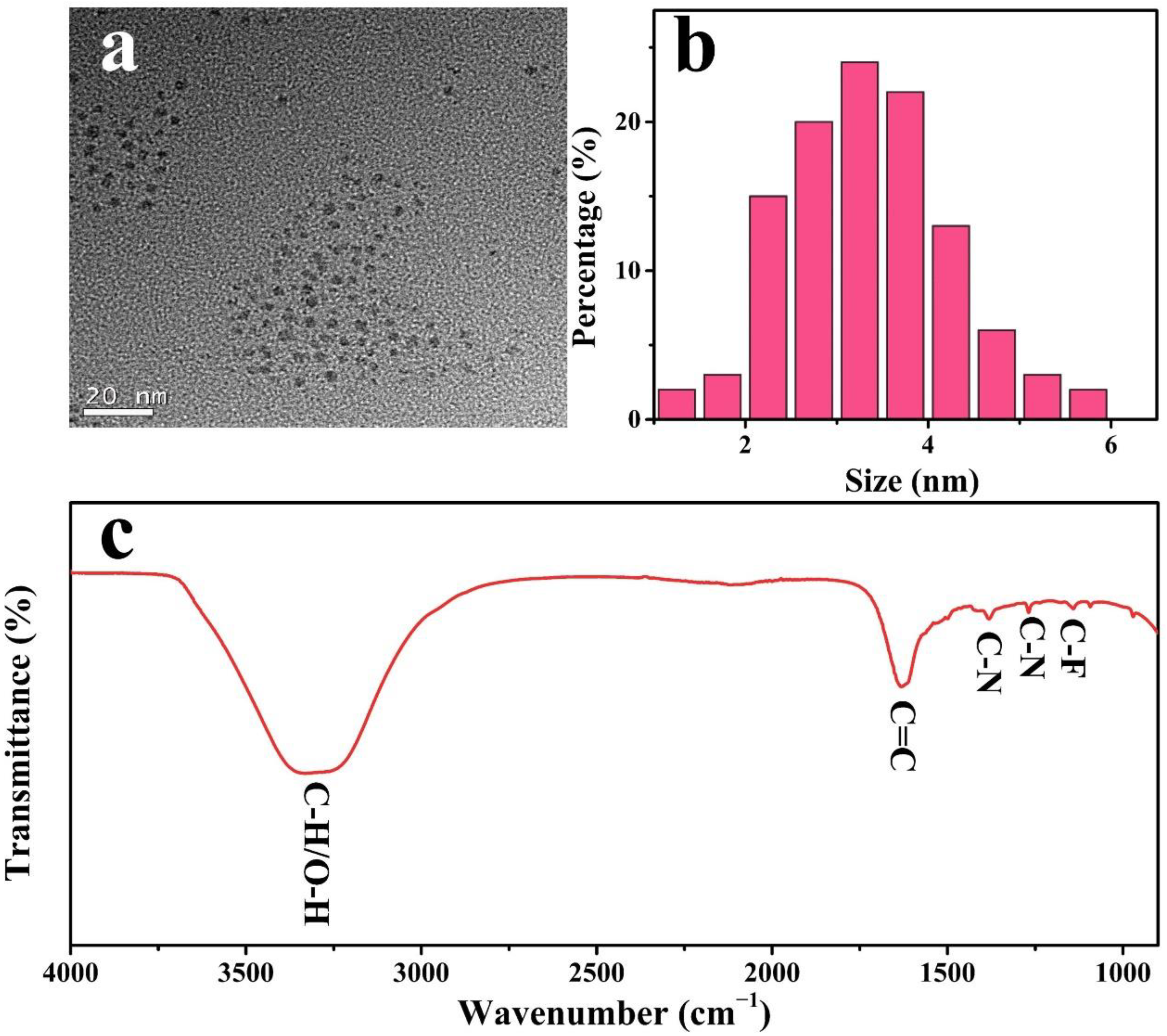
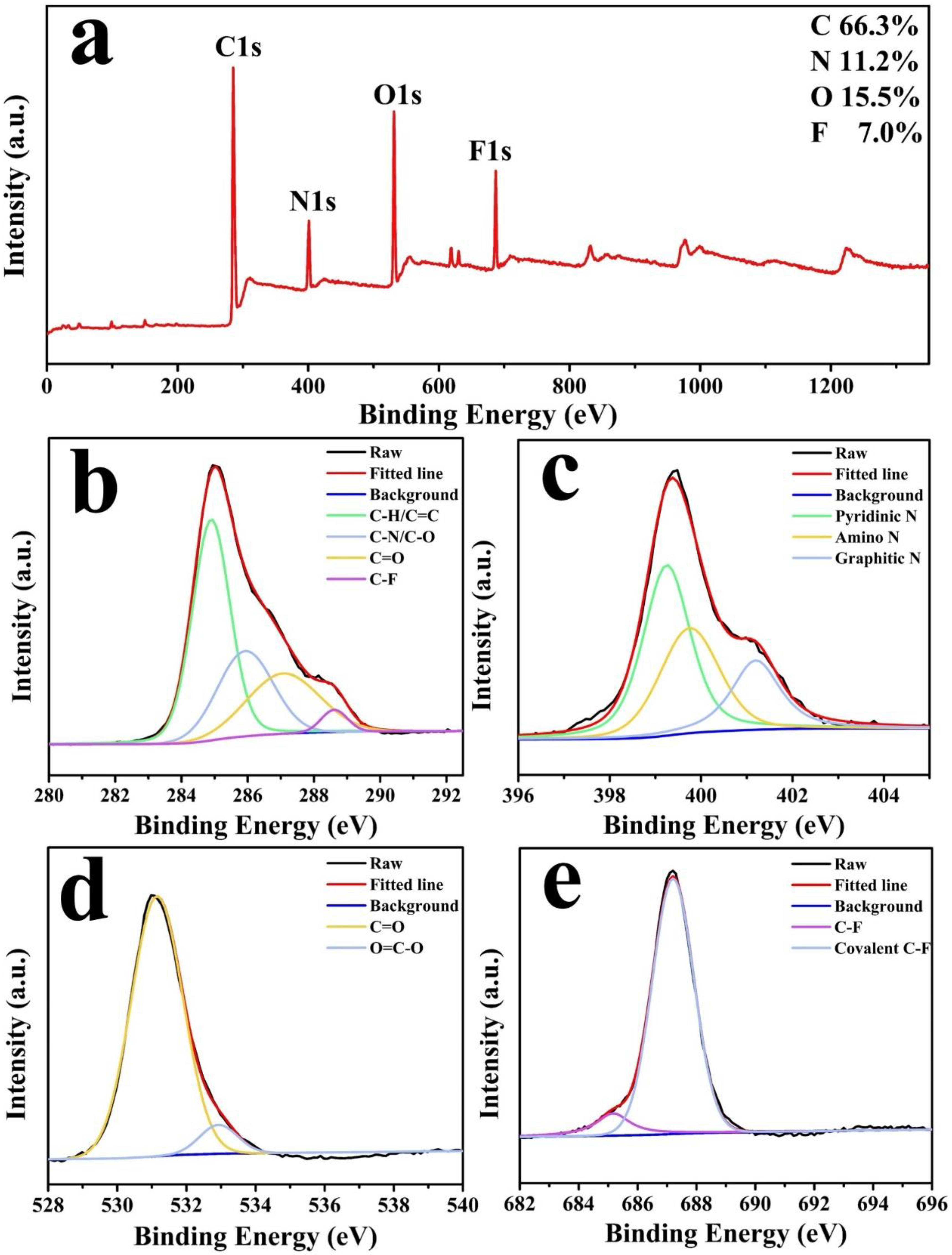
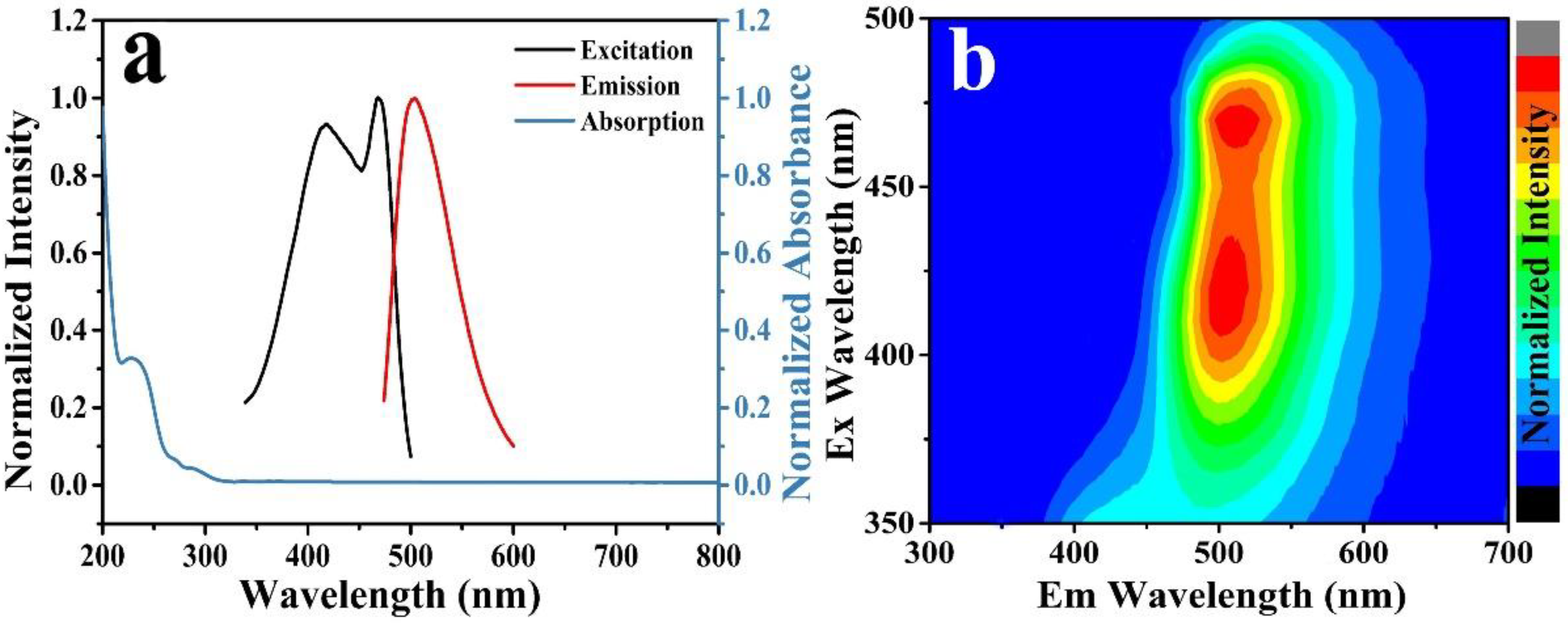
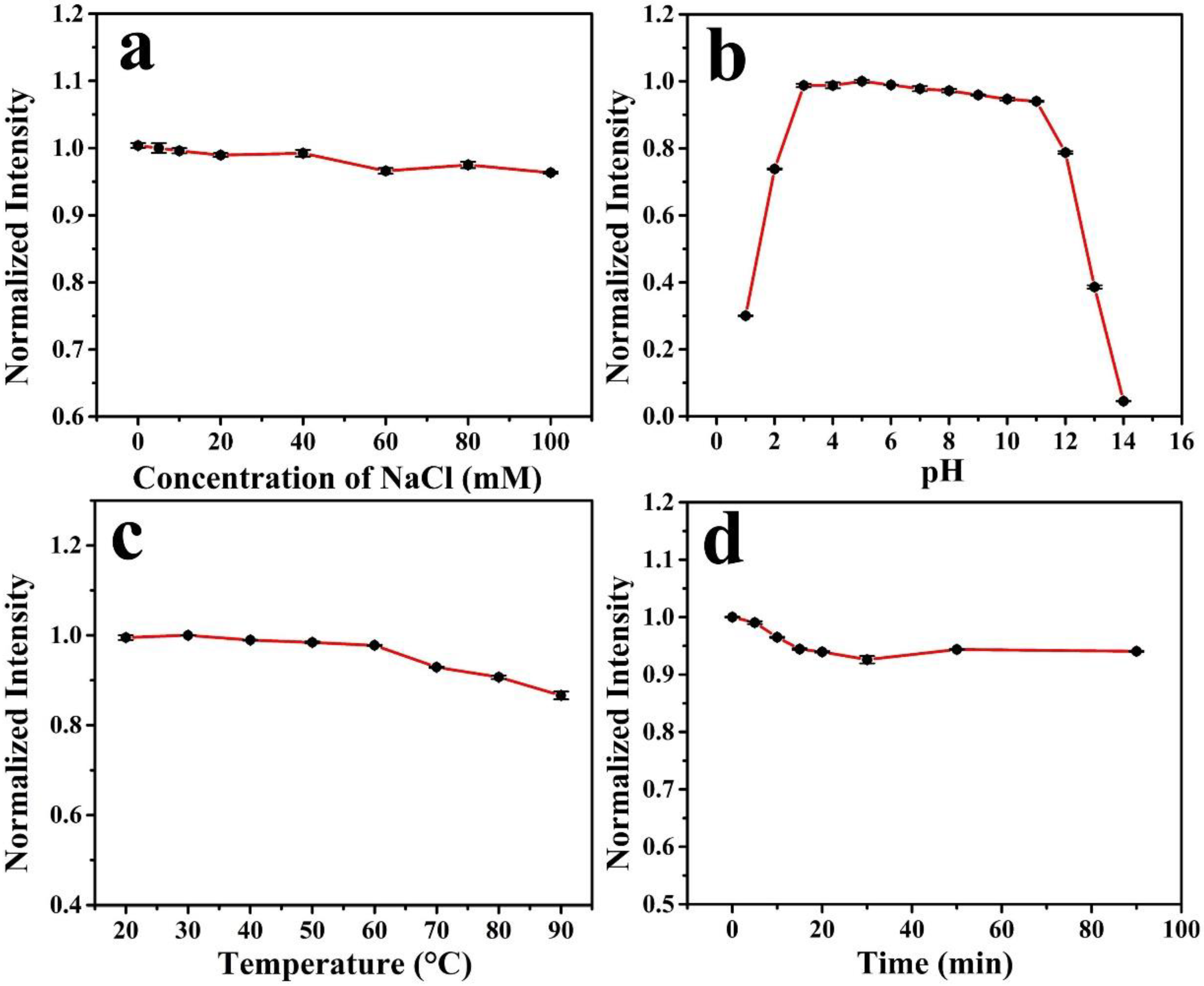
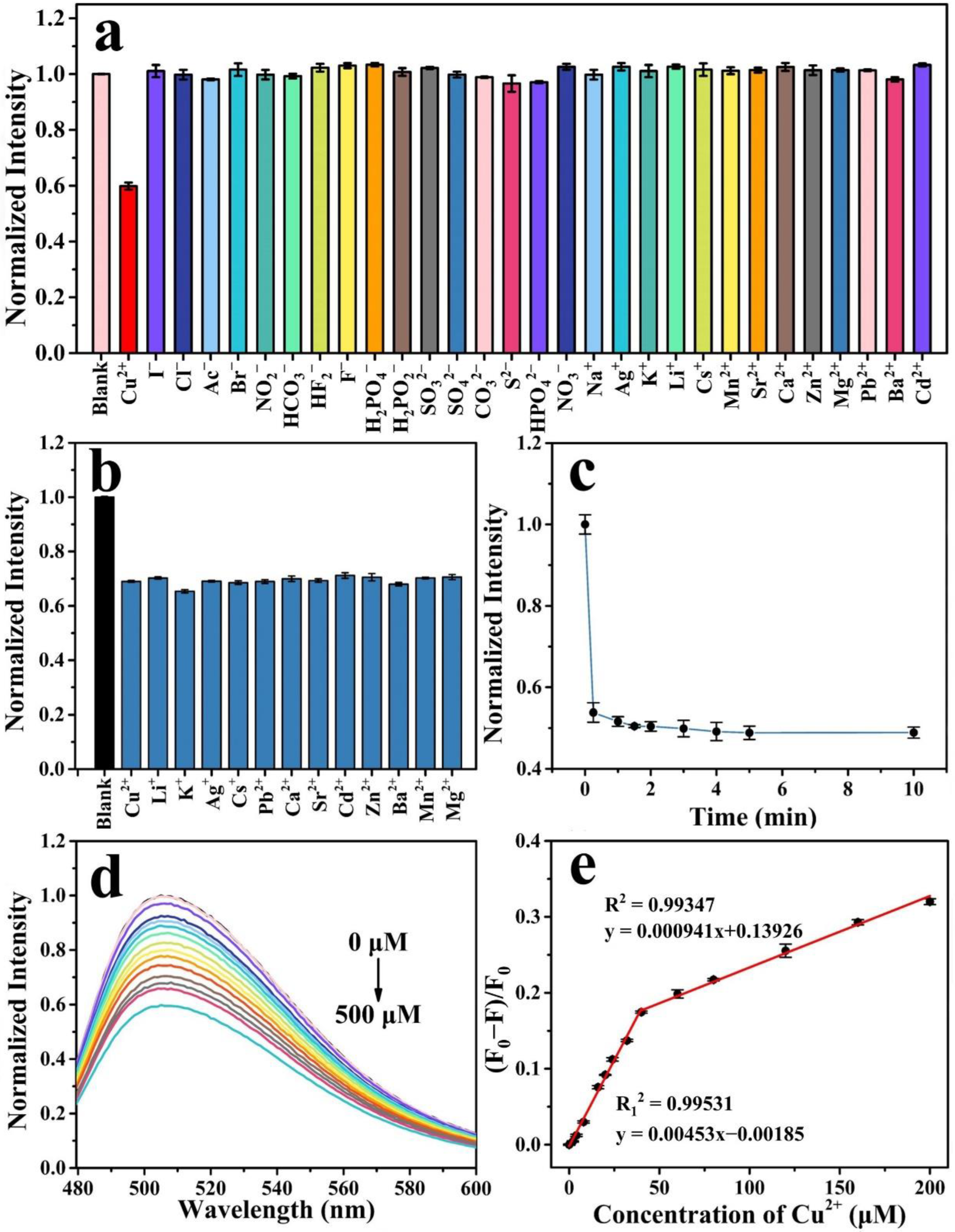
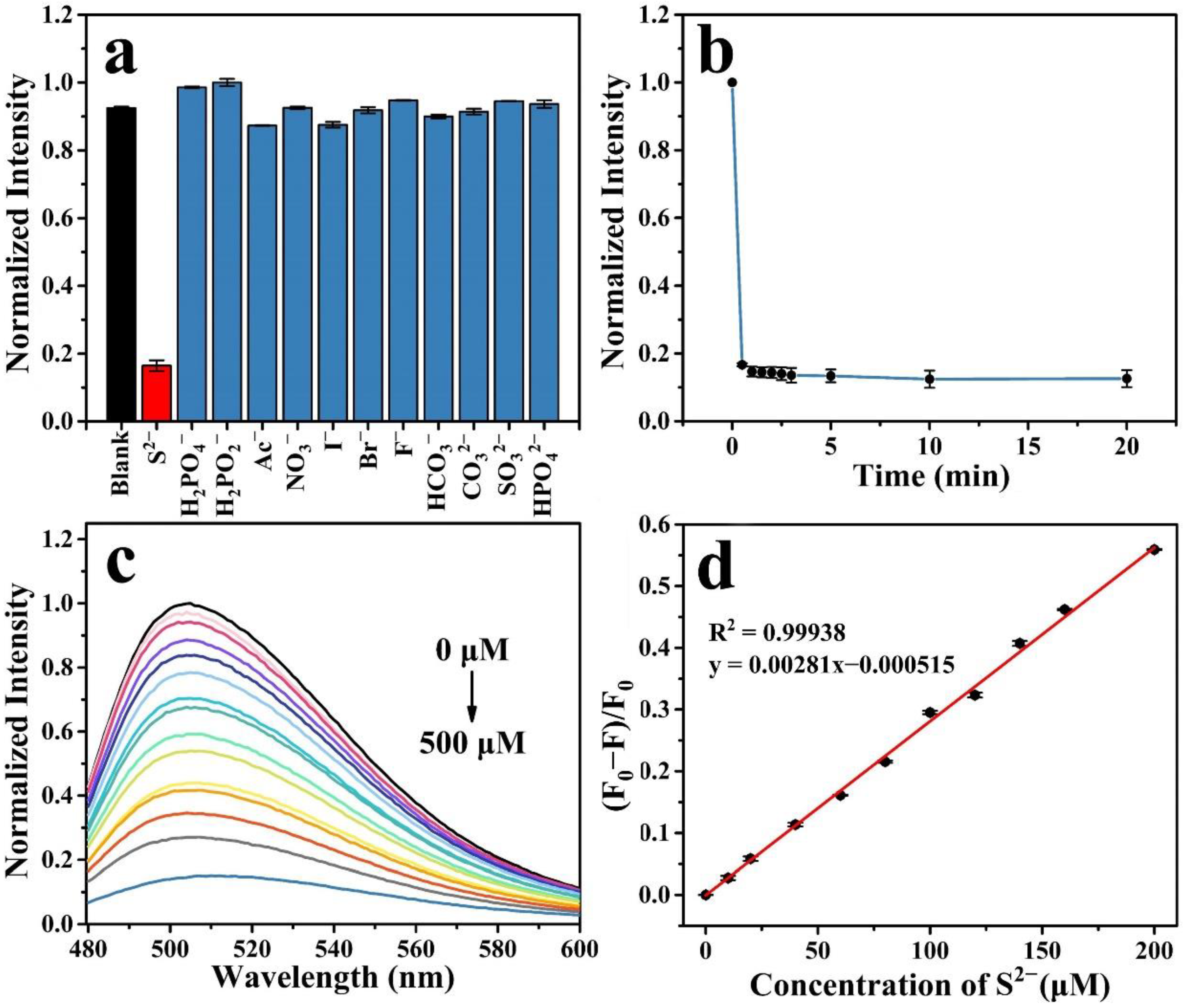
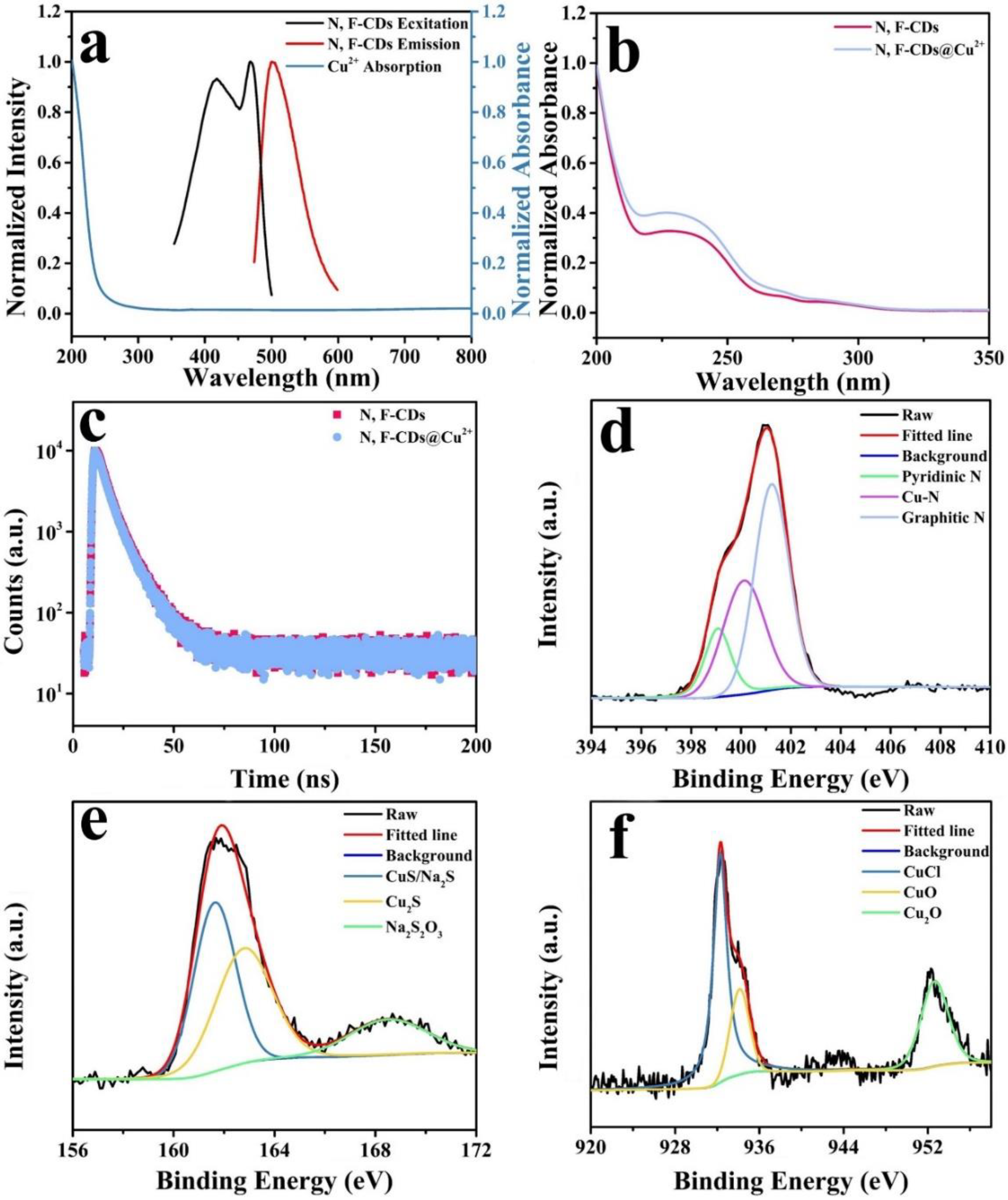
| Detection Condition | Linear Range (μM) | Detection Limit (μM) | Application | Reference |
|---|---|---|---|---|
| Carbon nanosheets | 20–40 | 4.9 | Lake water | [35] |
| d-CDs | 0.8–55 | 0.043 | Tea, Raisin, Kiwifruit | [36] |
| PEI-DA | 0–30 | 0.193 | Cell monitor | [37] |
| Fe3O4@AP-B(OH)2 nanocomposite | 1–30 | 0.3 | - | [38] |
| Gold nanoparticles | 0–108 | 5.8 | Lake water | [39] |
| N, F-CDs | 0–200 | 0.215 | Lake water, Tap water | This work |
| Detection Condition | Linear Range (μM) | Detection Limit (μM) | Application | Reference |
|---|---|---|---|---|
| F-SiNPs | 0–100 | 0.1 | Cell imaging | [40] |
| TSOC-Cu2+ | 0–60 | 0.362 | Cell imaging | [41] |
| CQDs-O-NBD | 0–10 | 0.18 | Cell imaging | [42] |
| N-doped CDs | 0.05–10 | 0.032 | Lake water | [43] |
| FCD-Cu2+ | 0–10 | 0.089 | Cell imaging | [44] |
| N, F-CDs@Cu2+ | 0–200 | 0.347 | Lake water, Tap water | This work |
| Sample | Spiked Cu2+ (μM) | Detected (μM) | Recovery (%) | RSD (n = 3) (%) |
|---|---|---|---|---|
| Lake water | 1 | 0.99 | 99.3 | 1.44 |
| 2 | 1.96 | 97.8 | 0.85 | |
| 4 | 4.11 | 102.8 | 1.30 | |
| Tap water | 1 | 1.02 | 102.1 | 0.33 |
| 2 | 2.06 | 103 | 0.95 | |
| 4 | 3.99 | 99.8 | 1.58 |
| Sample | Spiked S2− (μM) | Detected (μM) | Recovery (%) | RSD (n = 3) (%) |
|---|---|---|---|---|
| Lake water | 1 | 1.02 | 102.0 | 1.60 |
| 2 | 2.01 | 100.4 | 1.21 | |
| 4 | 3.94 | 98.6 | 1.46 | |
| Tap water | 1 | 0.98 | 97.7 | 1.88 |
| 2 | 2.06 | 103.1 | 3.89 | |
| 4 | 4.03 | 100.8 | 2.29 |
Publisher’s Note: MDPI stays neutral with regard to jurisdictional claims in published maps and institutional affiliations. |
© 2022 by the authors. Licensee MDPI, Basel, Switzerland. This article is an open access article distributed under the terms and conditions of the Creative Commons Attribution (CC BY) license (https://creativecommons.org/licenses/by/4.0/).
Share and Cite
Zeng, Y.; Xu, Z.; Guo, J.; Yu, X.; Zhao, P.; Song, J.; Qu, J.; Chen, Y.; Li, H. Bifunctional Nitrogen and Fluorine Co-Doped Carbon Dots for Selective Detection of Copper and Sulfide Ions in Real Water Samples. Molecules 2022, 27, 5149. https://doi.org/10.3390/molecules27165149
Zeng Y, Xu Z, Guo J, Yu X, Zhao P, Song J, Qu J, Chen Y, Li H. Bifunctional Nitrogen and Fluorine Co-Doped Carbon Dots for Selective Detection of Copper and Sulfide Ions in Real Water Samples. Molecules. 2022; 27(16):5149. https://doi.org/10.3390/molecules27165149
Chicago/Turabian StyleZeng, Yutian, Zhibin Xu, Jiaqing Guo, Xiantong Yu, Pengfei Zhao, Jun Song, Junle Qu, Yu Chen, and Hao Li. 2022. "Bifunctional Nitrogen and Fluorine Co-Doped Carbon Dots for Selective Detection of Copper and Sulfide Ions in Real Water Samples" Molecules 27, no. 16: 5149. https://doi.org/10.3390/molecules27165149
APA StyleZeng, Y., Xu, Z., Guo, J., Yu, X., Zhao, P., Song, J., Qu, J., Chen, Y., & Li, H. (2022). Bifunctional Nitrogen and Fluorine Co-Doped Carbon Dots for Selective Detection of Copper and Sulfide Ions in Real Water Samples. Molecules, 27(16), 5149. https://doi.org/10.3390/molecules27165149







